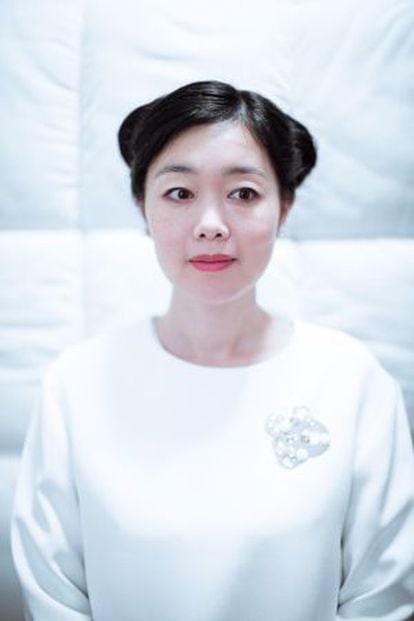

The sculpture was then hand painted with a signature paint coating. To achieve a form true to the highly precise concept, the sculpture was hand-formed by rolling and hammering sheet metal, with seams fully welded and hand-polished to achieve a perfectly smooth surface.

UAP worked collaboratively with the artist and gallery to engineer and build the site-specific sculpture, utilising new fabrication methods for the artist. Titled ‘Invisible Dimension’, the exhibition comprised of seven new sculptures, including the monumental Cycloid V - a large-scale, abstract organic form, wrapping the internal column of the gallery. Glass, stainless steel, LED, real time control system, 450 x 156.3 x 74.23 cm.Internationally recognised performance, video and installation artist Mariko Mori’s exhibition at Sean Kelly Gallery in New York explores the universal questions at the intersection of life, death, reality, and technology.

Immobile, the pendulum could point any direction, potentially encompassing the whole of the human experience.Ĭibachrome print, frame in diachronic glass, glass balls, crystal ball, chain, salt, 69 cm each element (set of 8 elements), Salt circle: 84.58 cm diameter. In one work, a crystal pendulum is suspended over a circle of 108 crystal balls - one for each of the 108 earthly desires. I’m not religious, but Buddhism and Shintoism are part of my cultural background, and Buddhists believe in transfiguration - reaching a deeper level of consciousness, transcending the self. A replica of a Jomon mask hangs on the wall above it, almost hovering like a deity over its realm. Human ritual meets scientific investigation into natural phenomena: Her floor piece “Flat Stone” (2006) echoes pebble shrines from the mid-Jomon Era (3500-2500 B.C.), aligned with the winter solstice’s light. Japanese-born Mori freely draws on Buddhist, Shintoist, and Celtic traditions that she reinterprets in a retro-futuristic lexicon, all muted hues and curved shapes.Ĭeramic stones and acrylic vase, Stones: 487.5 x 314.6 x 8.8 cm, Vase 38.1 x 27.9 x 43.2 cm. With its combination of an ancient form and cutting-edge technology, this first piece sums up most of the sources behind the show. Stone, corian, LED, real time control system Overall dimensions: 336 cm Diameter: 110 x 56 x 34 cm (each stone) Mariko Mori, ‘Transcircle 1.1’ (Indoor), 2004. These interests are expressed through emerging technologies and digital media, which the artist embraces as tools to be harnessed in order to reconnect with our environment. Founded on a belief in cycles of death and rebirth, these were marked by a holistic world view that placed mankind in a more harmonious relationship with our surroundings. Mori’s recent practice has evolved around a fascination with ancient cultures, among them prehistoric Jomon (c.14,000 – 300 BC) in Japan and Celtic traditions in Europe. Her works juxtapose contrasting aesthetic languages that have ranged from traditional tea ceremonies to Manga and cyber culture, fusing Shintoism and Buddhism with the hard planes of science and technology.

Since her first exhibitions in the mid-1990s, Mori’s practice has been rooted in both traditional and contemporary Japanese culture, and between East and West. According to ancient calendars, this year’s solstice will either mark the end of the world or the birth of a new era. The exhibition has been developed in close collaboration with the artist, and is timed to coincide with the winter solstice in 2012. Starting and ending with the death and birth of a star, the cycle of life and rebirth is an important theme of the show, which includes photography, works on paper, sound works, as well as sculpture and large scale immersive installations and environments that invite contemplation. Mariko Mori’s Rebirth includes some of her most acclaimed works from the last 11 years, alongside new works created especially for this exhibition.


 0 kommentar(er)
0 kommentar(er)
